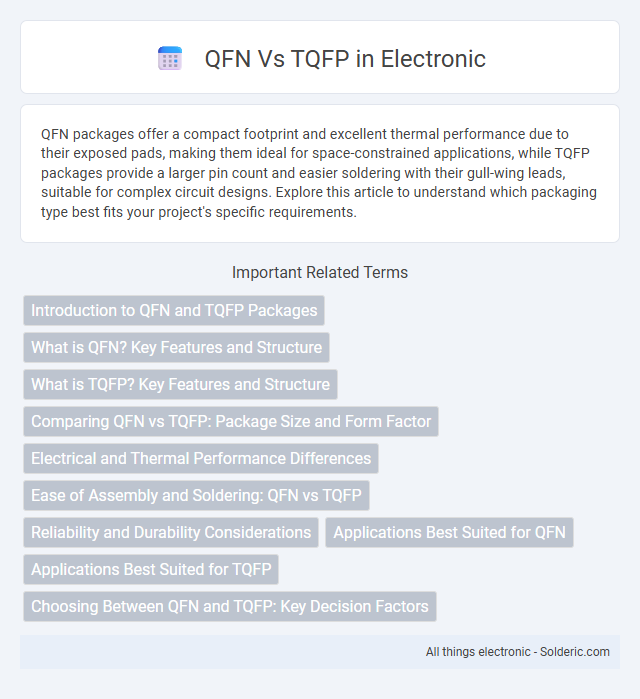QFN packages offer a compact footprint and excellent thermal performance due to their exposed pads, making them ideal for space-constrained applications, while TQFP packages provide a larger pin count and easier soldering with their gull-wing leads, suitable for complex circuit designs. Explore this article to understand which packaging type best fits your project's specific requirements.
Comparison Table
| Feature | QFN (Quad Flat No-Lead) | TQFP (Thin Quad Flat Package) |
|---|---|---|
| Package Type | Leadless, flat | Leaded, flat |
| Size | Smaller footprint, compact | Larger footprint, thin profile |
| Thermal Performance | Superior heat dissipation | Moderate heat dissipation |
| Electrical Performance | Lower inductance and resistance | Higher parasitic inductance |
| Pin Count | Typically up to 100 pins | Up to 144 pins or more |
| Assembly | Requires precise soldering, advanced PCB | Easier manual inspection and soldering |
| Application | High-frequency, space-critical designs | General-purpose, complex ICs |
Introduction to QFN and TQFP Packages
QFN (Quad Flat No-Lead) packages feature a bottom-terminated design that offers excellent thermal performance and a compact footprint ideal for high-density PCB layouts. TQFP (Thin Quad Flat Package) is a leaded, surface-mount package with gull-wing leads extending from each side, providing ease of inspection and rework for medium-pin-count applications. Choosing between your QFN and TQFP packages depends on factors like space constraints, thermal management needs, and assembly complexity.
What is QFN? Key Features and Structure
QFN (Quad Flat No-Lead) is a surface-mount integrated circuit package characterized by its leadless design and flat contacts underneath the package, optimizing thermal and electrical performance. Key features include a compact footprint, low profile, excellent heat dissipation through exposed pads, and reduced parasitic inductance, making it ideal for high-frequency applications. The structure consists of a square or rectangular plastic mold encapsulating the die, with metal pads arranged around the perimeter on the package bottom for efficient soldering and connection to the PCB.
What is TQFP? Key Features and Structure
TQFP (Thin Quad Flat Package) is a surface-mount integrated circuit package featuring a flat, thin body with gull-wing leads extending from all four sides, making it ideal for high-density PCB layouts. Its structure includes a rectangular or square plastic housing with leads bent outward to facilitate soldering, optimizing thermal performance and mechanical stability. Key features of TQFP include a low profile, excellent heat dissipation, and compatibility with automated assembly processes, commonly used in microcontrollers, ASICs, and other semiconductor devices.
Comparing QFN vs TQFP: Package Size and Form Factor
QFN (Quad Flat No-Lead) packages feature a smaller footprint and lower profile compared to TQFP (Thin Quad Flat Package), making them ideal for space-constrained applications. TQFP packages offer larger body dimensions and exposed leads, facilitating easier manual soldering and inspection in prototyping environments. Choosing between QFN and TQFP depends on your priority for compact design versus ease of assembly and testing in your electronics project.
Electrical and Thermal Performance Differences
QFN (Quad Flat No-Lead) packages offer superior electrical performance due to shorter current paths and reduced parasitic inductance compared to TQFP (Thin Quad Flat Package) designs, enhancing signal integrity in high-frequency applications. Thermal performance in QFN packages is improved by an exposed thermal pad on the underside that facilitates efficient heat dissipation directly to the PCB, whereas TQFP packages rely on lead frames and longer heat paths, resulting in less effective thermal conductivity. These characteristics make QFN more suitable for compact, high-performance devices requiring enhanced electrical and thermal management.
Ease of Assembly and Soldering: QFN vs TQFP
QFN packages offer superior ease of assembly and soldering due to their flat, leadless design that enables better thermal and electrical performance with minimal solder joints, reducing the risk of bridging and defects. TQFP packages, with their exposed leads on all four sides, require more precise alignment and careful soldering to avoid shorts or open circuits, which can increase assembly time and cost. Your choice between QFN and TQFP should consider the manufacturing environment and assembly capabilities to optimize soldering reliability and efficiency.
Reliability and Durability Considerations
QFN packages offer superior reliability compared to TQFP due to their shorter lead lengths, which reduce inductance and improve thermal performance, enhancing durability in high-stress environments. TQFP packages, while easier to inspect and rework, are more susceptible to mechanical stress and solder joint fatigue because of their exposed leads. Your choice between QFN and TQFP should consider the operating environment and mechanical demands to ensure long-term reliability and durability.
Applications Best Suited for QFN
QFN (Quad Flat No-Lead) packages are best suited for high-frequency applications, RF modules, and compact consumer electronics due to their low inductance and excellent thermal performance. Their small footprint and superior heat dissipation make them ideal for mobile devices, wearable technology, and automotive sensors where space and reliability are critical. QFN is preferred in power management and wireless communication circuits that require efficient electrical performance and minimal signal loss.
Applications Best Suited for TQFP
TQFP (Thin Quad Flat Package) is best suited for applications requiring moderate pin counts with easy visual inspection and rework capabilities, such as microcontrollers, DSPs, and low-to-medium complexity ICs in consumer electronics. Its larger footprint and exposed leads simplify prototyping and manufacturing in automotive, industrial control, and communication devices. TQFP's strong thermal performance and straightforward soldering process make it ideal for products where durability and serviceability are critical.
Choosing Between QFN and TQFP: Key Decision Factors
Choosing between QFN (Quad Flat No-Lead) and TQFP (Thin Quad Flat Package) depends on factors like board space, thermal performance, and assembly complexity. QFN offers a smaller footprint and superior heat dissipation, making it ideal for compact devices requiring efficient thermal management. Your decision should weigh the trade-offs between QFN's space-saving benefits and TQFP's ease of inspection and soldering.
QFN vs TQFP Infographic

 solderic.com
solderic.com